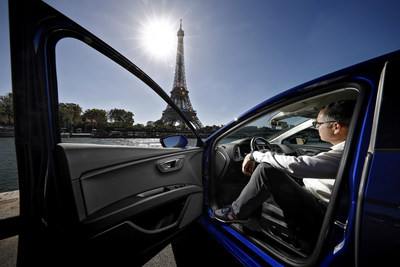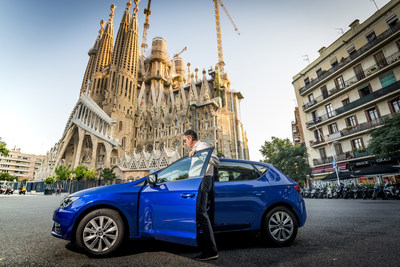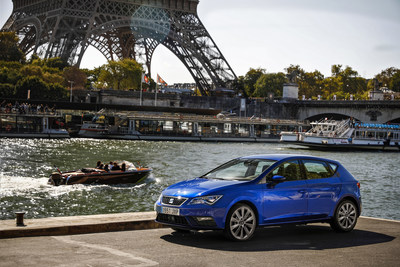MARTORELL, Spain, October 1, 2018 /PRNewswire/ --
- An expert in CNG accepts the challenge of driving more than 1,000 km from Barcelona to Paris in a gas powered car to evaluateits consumption and cost
- The total cost in fuel was €45 and he made two stops to refuel
- Driving with these sustainable vehicles enables you to access European cities such as Paris and Barcelona when there are traffic restrictions due to high pollution levels




(Logo: https://mma.prnewswire.com/media/645629/SEAT_Logo.jpg )
(Photo: https://mma.prnewswire.com/media/751722/SEAT_Paris.jpg )
(Photo: https://mma.prnewswire.com/media/751716/SEAT_Sagrada_Familia.jpg )
(Photo: https://mma.prnewswire.com/media/751719/SEAT_Eiffel_Tower.jpg )
YouTube Video: https://www.youtube.com/watch?v=wLAJzSw2IZU&feature=youtu.be
What is the cost in fuel to drive from Barcelona to Paris? Antonio Calvo, Head of Sustainable Mobility at SEAT, gets behind the wheel of a SEAT Leon 1.5 TGI to take on the more than 1,000 km drive and calculate how much it costs to get there. The following log details the trip in a gas powered car to the French capital, where the International Car Show is opening this week:
- Starting point, the Sagrada Familia: Antonio Calvo sets off first thing in the morning from the steps of Antoni Gaudí's basilica with a full tank of gas. Just a few kilometres into the challenge, the expert verifies that, "When you drive this kind of vehicle, the feeling is exactly the same as with a petrol car. You don't feel any difference in the dynamic performance or power."
- Barcelona-Toulouse, for €15: Antonio Calvo crosses the border with France and covers a distance of over 400 km without stopping, at an average speed of 120 km/h. He makes his first stop to refuel when leaving the city of Toulouse. While filling the tank, he comments that, "The process is very simple, as the universal nozzle enables you to refuel as usual at any gas station." So far, he has spent €15 and has about 680 km to go until reaching his final destination.
- Next stop, Limoges: While driving through the French countryside, this expert points out that, "Driving a car powered with natural gas reduces CO2 emissions by 25% compared to a petrol car and nitrogen oxides by 75% compared to a diesel." Antonio arrives to Limoges, where he stops again to refuel: "I've now covered 684 km and spent €25 on about 24 kg of gas," he says. For the challenge, he has to cover the entire distance with this alternative fuel. The car drives on compressed natural gas by default, even though it also has a petrol tank, which only switches over when the compressed natural gas is depleted.
- Last 392 km to the City of Light: Antonio starts out on the last leg of his trip, and when arriving at the city limits of Paris he faces the possibility of traffic restrictions to access the city centre during episodes of air pollution. With a population of more than two million people, this expert recalls that this city, "Is putting more and more restrictions on the most polluting cars. But as I'm driving this CNG car I can make it in without any problems, even if there were traffic restrictions today due to high pollution levels. Mobility using vehicular natural gas is considered by the EU as environmentally efficient due to its low emissions."
- Challenge accomplished at the foot of the Eiffel Tower: Upon arrival at the Champs-Élysées, the head of Sustainable Mobility makes his final assessment of the trip: "I covered a total distance of 1,076 km and spent only €45, which amounts to an average of 3.6 kg of gas for every 100 km. The cost savings is certainly one of the many advantages of CNG. In fact, if I had made the same trip with a petrol powered car it would have cost me 50% more; and 30% more if it had been a diesel," he concludes. This expert assures that compressed natural gas cars are a growing trend. There are more than 1.3 million vehicles driving on European roads with this kind of fuel, with Italy as the main market.
Antonio Calvo's challenge at the wheel of a CNG powered car coincides with the Paris International Motor Show, where SEAT is going to reveal the new Arona TGI, the world's first SUV that is powered with this alternative fuel. Alongside the Leon, the Ibiza and the Mii, the company is going to offer one of the most comprehensive lineups of CNG fuelled cars.
SEAT is the only company that designs, develops, manufactures and markets cars in Spain. A member of the Volkswagen Group, the multinational has its headquarters in Martorell (Barcelona), exporting 80% of its vehicles, and is present in over 80 countries on all five continents. In 2017, SEAT obtained an after tax profit of 281 million euros, sold close to 470,000 cars and achieved a record turnover of more than 9.5 billion euros.
The SEAT Group employs more than 15,000 professionals and has three production centres - Barcelona, El Prat de Llobregat and Martorell, where it manufactures the highly successful Ibiza, Arona and Leon. Additionally, the company produces the Ateca and the Toledo in the Czech Republic, the Alhambra in Portugal and the Mii in Slovakia.
The multinational has a Technical Centre, which operates as a knowledge hub that brings together 1,000 engineers who are focussed on developing innovation for Spain's largest industrial investor in R&D. SEAT already features the latest connectivity technology in its vehicle range and is currently engaged in the company's global digitalisation process to promote the mobility of the future.
Share this article